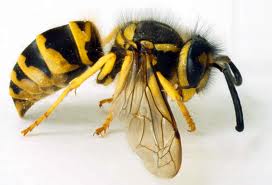Yellowjackets and paper wasps
are beneficial insects. They feed
their young numerous insects
that ordinarily damage shade
trees and crops. They also kill
countless houseflies and blow
flies.
A few species of yellowjackets,
however, such as Vespula pensylvanica
(western yellowjacket),
V. germanica (German wasp),
and V. vulgaris (common yellowjacket),
scavenge for meat and
sweets and can become pests,
especially at picnics and campgrounds.
Even though they may
at times become pests, yellowjackets
and paper wasps are
highly beneficial. Do not control
them unless their stings present
a hazard.
Life Cycle
In the Pacific Northwest, yellowjackets
and paper wasps have
annual colonies. The only colony
members to overwinter are inseminated
queens, which spend the
winter in protected locations, such
as under bark, in stumps and
logs, and within stacks of firewood.
The native Polistes aurifer
(golden paper wasp) frequently
overwinters in attics of homes.
The queens emerge during the
first warm days of spring (as
early as March and April), select
a nest site, and build a small
paper nest in which they lay
their eggs. When the eggs hatch,
the queen feeds the young larvae
for up to 3 weeks. Larvae then
pupate, to emerge as smaller
infertile females called workers.
Once the first five to seven workers
appear, they begin rearing
and feeding the brood. The queen
rarely is seen again outside the
nest. The colony then expands
rapidly, and depending on the
species, may consist of as many
as 5,000 workers and 15,000
cells in the nest for some yellowjacket
species.
Colonies attain maximum size
in August and September. Worker
yellowjackets, then at their peak,
become pestiferous. About this
time, new males and queens are
produced from reproductive cells.
These emerge and mate. The
males soon die, and the inseminated
queens seek sheltered locations
in which to overwinter. The
abandoned nests rapidly decompose
and disintegrate during the
winter. They are not used again.
In spring, the cycle starts over.
The German wasp has become
widespread in Washington.
The cycle of this yellowjacket is
slightly later, with peak colony
size occurring in October and
early November. This species has
a propensity for nesting in structures
and has become a widespread
urban pest. Recently, the
European paper wasp (Polistes
dominulus) also has become widespread
and abundant throughout
Washington. It readily nests
on and within human-made
structures and is particularly
populous in urban and suburban
areas. The tendency of the
German and European species
to found nests in association
with people contributes to their
pest status.
